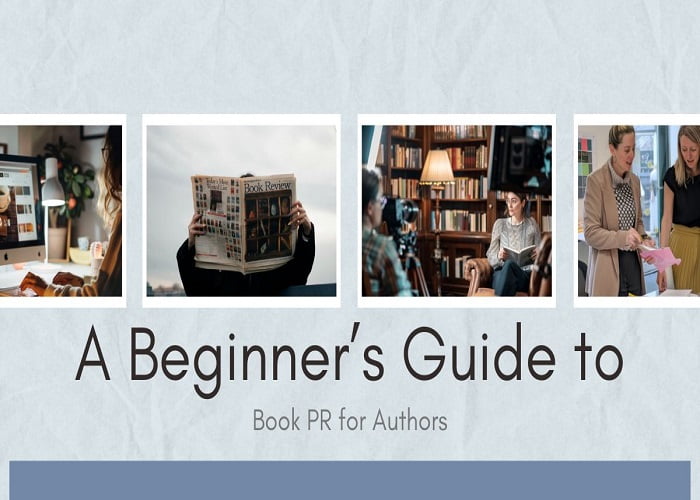
Ever wondered how to skyrocket your book’s success through strategic PR?
If you’ve read some of my other blog posts on public relations (PR), you know I’m a big advocate of using PR campaigns to expand an author’s readership. In this beginner’s guide to book PR for authors, I’m spilling all the secrets.
For many authors, PR starts and stops with a press release that doesn’t land them any interviews or testimonials. Press releases might snag backlinks to your website, but if you’re aiming for media interviews and journalist testimonials, they’re not the way to go. When it comes to book PR for authors, there’s a lot more to crafting a successful strategy. Press releases won’t fund your next book.

Authors with a stellar book (and book cover) that resonates with readers can reap numerous benefits from PR aimed at Getting Publicity For Your Book. Apart from the obvious perk of publicity, authors can build credibility and trust within their target audience. Potential book buyers often rely heavily on media opinions when seeking a new read. Before making a purchase, they’ll scour the book’s reviews and testimonials. Why? Because for your target reader, buying a book isn’t just a financial investment; it’s an investment of time. To convince them to invest their time, they need to trust.
Why Do Authors Need PR for Their Book?
There are two main reasons why authors need PR for their book. The first reason is that it builds credibility. Having a testimonial or interview from a media outlet gives your book a stamp of approval with your readership. The second reason is that PR can lead to more sales. Getting sales for a PR strategy is a bit more complicated as it is difficult to measure the return on investment. PR is a part of that sales process. For example, people need multiple touch points with you before they decide that they want to purchase your book. PR is one of those touch points.
What is PR? Why Is it Different From Advertising and Other Kinds of Marketing?
Essentially, PR is free coverage in media outlets. These media outlets can be magazines, newspapers, radio shows, TV shows, podcast episodes, or YouTube channels. It is basically coverage in outlets that have hundreds of thousands of people following them and consuming their content. PR is not the same as advertising in which you buy a sponsored article in a media outlet. Instead, you work with producers, editors, and journalists to create content that their readers will want to consume.
What is Modern Book PR for Authors?
The modern book PR landscape looks very different compared to just a few years ago. As such, many guides to book PR for authors are out of date. Online media outlets, influencers, podcasts, and blogs have started to gain more online power than ever. Some online outlets now have bigger audiences than traditional magazines or newspapers (such as the Huffington Post).
In response to this, the book PR industry, much like the marketing industry, has evolved rapidly over the last decade. The biggest evolution within the book PR industry is creating PR campaigns that work with both traditional and digital media.

What Is Traditional PR and Digital PR?
Traditional PR and digital PR are two key pillars of any comprehensive PR campaign for authors, each offering unique advantages.
Traditional PR encompasses strategies aimed at garnering attention through conventional media channels such as newspapers, magazines, radio, and television. It’s particularly effective for crisis management, shaping public perception, and reaching a dedicated audience engaged with traditional media. For authors, traditional PR can secure features in prominent literary magazines, interviews on radio shows, or reviews in newspapers, elevating their visibility and credibility within the literary community.
On the other hand, digital PR focuses on leveraging online platforms and channels to enhance visibility and reputation. This includes online publications, blogs, social media, and other digital platforms. Unlike traditional PR, digital PR content has a longer lifespan and can continue to generate traction over time. Additionally, digital PR offers direct Search Engine Optimization (SEO) benefits, as online coverage and mentions contribute to improving your website’s search engine rankings.
Moreover, quality referral traffic generated from online media outlets can drive a steady stream of visitors to your author website or Amazon book page. This sustained online presence not only boosts visibility but also increases the likelihood of book sales and engagement with your target audience. Therefore, incorporating both traditional and digital PR strategies into your campaign ensures a comprehensive approach that maximizes exposure and impact for your book and author profile.
Understanding that the Result of PR Is All About Getting Earned Media Coverage
When we refer to earned media for book PR aimed at Getting Publicity For Your Book, we mean any channel, media outlet, or medium of influence that has mentioned your book or author name. Earned media is the opposite of paid media. Paid media is in the domain of marketing, so is not a part of a PR strategy. Paid media involves paying the media to advertise your book to their audience. With PR, you never pay the media to share information about your book or to interview you.

How to Win Earned Media for Your Book
Winning earned media for your book requires a well-thought-out PR strategy and a compelling pitch that grabs the attention of journalists and media outlets. Here’s how you can effectively secure media coverage:
- Develop a Story and Media Kit: Start by crafting a compelling story or angle related to your book that will resonate with the media and their audience. This could include your journey as an author, the inspiration behind your book, or any unique aspects of your story. Additionally, create a comprehensive media kit that includes essential information about you as the author and your book. This kit will serve as a valuable resource for journalists, providing them with everything they need to know to write a story or feature about you.
- Craft a Value-Driven Pitch: When reaching out to journalists and media outlets, ensure that your pitch offers genuine value. Avoid simply promoting your book with generic messages like “Buy my book now,” as this is likely to be ignored. Instead, focus on what makes your story interesting and relevant to their audience. Keep your pitch short, concise, and to the point, highlighting the most compelling aspects of your book and why it deserves media coverage.
- Personalize Your Pitches: Tailor each pitch to the specific journalist or media outlet you’re targeting. Research their interests, previous work, and audience demographics to ensure that your pitch aligns with their preferences and coverage areas. Personalization demonstrates that you’ve taken the time to understand their needs and increases the likelihood of your pitch being well-received.
- Follow Up Strategically: After sending your initial pitch, follow up with journalists in a polite and professional manner. Give them some time to review your pitch before following up, and be prepared to provide additional information or answer any questions they may have. However, avoid being overly persistent or aggressive, as this can have a negative impact on your relationship with the media.
By implementing these strategies and focusing on delivering value to journalists, you can increase your chances of winning earned media coverage for your book and reaching a wider audience.

Cookie Cutter Pitches Don’t Work in Getting Media Coverage
PR has changed dramatically over the years. Now, a great PR strategy focuses on building relationships with the media earlier on. When implementing a PR strategy you want to focus on human relations and making friends with the media, not contacts. Why? Because cold emails don’t work. Cold emails sent to a list of “contacts” don’t leave a lasting impression – they just look like spam. Cookie-cutter emails annoy the media. Plus, journalists can spot a mass email miles away (and it doesn’t look good for a new author). Not surprisingly, word travels fast in the small world of media. The last thing you want is to develop a spammy reputation.
https://www.pexels.com/photo/black-and-gray-digital-device-193003/
So, don’t send cold emails – instead, send personal ones where the email reads like you want to build a relationship with the journalists themselves. Just as you would invest in relationships with readers you must also invest in building genuine relationships with journalists. Time is precious, especially if you would rather spend more time writing your next book. Instead of focusing all your efforts on cold pitching to as many media outlets as you can, why not concentrate on pitching to fewer in a more strategic, relationship-focused way?
How to Build Relationships with the Media
https://www.pexels.com/photo/two-person-in-long-sleeved-shirt-shakehand-955395/
To build relationships with the media you need to first start small. It is common for authors to want to go big right away. But when it comes to getting media coverage I recommend a ladder approach. The ladder approach is where you start small and then gradually go bigger. Once you get some local media coverage, you will automatically start to get noticed by larger media outlets.
But before you even get that first local media interview you want to start even smaller. You can begin by simply engaging with journalists over social media – reply to or retweet one of their tweets or comment on one of their recent articles. Your goal is for the journalists to start recognizing your name. Before pitching to the media you need to build relationships with them.
Once you have engaged journalists over social media, send them a friendly introduction email. Make your introduction and tell them a bit about who you are and what your book is about. Make this introduction email very short – no one will read an essay. Reinforce that you believe you could potentially be of benefit to them by offering your insight or relevant story material. Your email should stress how you can be of value to them. Great book PR for authors is selfless in nature and works to support what the media’s audience would be interested in.
Key Items to Remember to Include in Your Pitch for Your Book
- Be brief. When sending an introduction email, do so in a short and meaningful way. Briefly explain who you are and why their readership would be interested in your book. Remember, the media consists of journalists and they want emails that they can easily skim.
- Be genuine. Don’t fake familiarity or be creepy. Focus on providing real value that you truly believe will benefit them. Tell what they need to know – get straight to the point. If your email is truly genuine it will show.
- Listen. Never underestimate the power of listening. If the media declines, it may seem tempting to pressure them until they say yes. Don’t ever do this! Instead, be understanding and tell them that they are always free to reach out to you in the future if they are looking for anything similar to your pitch. Or, you can ask what type of stories they are interested in featuring this season.
By keeping these three key items in mind and concentrating on pitching real value, you will see greater success in achieving media coverage. The media is looking to feature genuine stories from people who don’t waste their time.
How to Measure Your Book’s PR Results
The impact of book PR for authors needs to be measured and tracked. A common misconception is that the effects of PR are intangible and can’t be quantified. It is true that in the pre-digital era measuring the impact of PR could be difficult. But in the digital age, that’s all changed. While you still can’t necessarily put a number on credibility and it is challenging to track results, you can measure Key Performance Indicators (KPIs) and Key Output Metrics.
How to Measure KPIs for Your Book PR Campaign
KPIs, or Key Performance Indicators, measure the impact of your PR activity against your PR goals. As your PR goals are dependent on your book’s goals, KPIs can vary from author to author.
Here is a list of common KPIs:
- Website traffic – How much traffic is coming to your landing page from earned media referrals?
- Social engagement – How many people are engaging with your social media content?
- Book sales – Did you have an increase in book sales when the media mentioned you?
Keep in mind that for some of these KPIs you will have to estimate, as the media won’t give you their analytics.
How to Measure Key Output Metrics for Your Book PR Campaign
Key output metrics are the measurements of your earned media wins. These measurements enable you to see if you are on the right track with your media wins.
Here is a list of common key output metrics:
- Mentions – How many mentions did you get with the media?
- Backlinks – How many backlinks did you get through earned media?
- Sentiments – What was the quality of the mentions, interviews, and/or features?
Remember, regular media monitoring is essential to understanding if your book PR strategy was a success or not.
Key Takeaways and Next Steps Towards Getting Publicity For Your Book
Above are the main points on how to create and implement a book PR strategy for authors aimed at Getting Publicity For Your Book. Remember, the main point of PR is to help authors and books build trust, legitimacy, and reputation with their readership. These are the foundations that all authors and books need to grow and achieve their goals, ultimately leading to more book sales.
If you are looking for more help with book PR, please reach out and schedule a free consultation. We will walk you through the next steps you need to take to start getting the media’s attention.

Leave a Reply